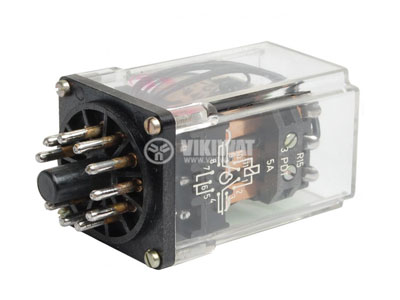Key Takeaway
Relays can work with both AC and DC, depending on their design. The relay contacts have AC and DC ratings for current and voltage, allowing them to switch either type of current. However, the relay coil determines the specific type needed. For an AC relay, you need an AC coil, and for a DC relay, you need a DC coil. Always check the relay specifications to ensure compatibility with your circuit’s power type. This ensures proper operation and longevity of the relay.
AC Relay Requirements
AC relays are designed to operate with alternating current. They typically include components like shading rings to prevent the relay from chattering during operation. Chattering occurs because AC current fluctuates and crosses zero volts during each cycle, which can cause the relay contacts to vibrate. Shading rings help maintain a steady magnetic field, ensuring smooth operation. AC relays are well-suited for applications that utilize standard household or industrial power supplies, such as controlling large motors, HVAC systems, and other high-power electrical devices. Their ability to handle higher voltages and currents makes them ideal for heavy-duty applications.

DC Relay Requirements
DC relays operate with direct current, providing a constant voltage without the fluctuations seen in AC. This constant voltage makes DC relays simpler in design, as they do not require shading rings to maintain stable operation. DC relays are typically used in low-voltage applications such as automotive systems, telecommunications, and battery-operated devices. These relays are particularly advantageous in scenarios requiring precise control and quick response times. For example, in automotive applications, DC relays control various electrical components like lights, wipers, and fans. The steady nature of DC makes these relays suitable for sensitive electronics that require consistent power.
In telecommunications, DC relays are essential for signal routing and switching, ensuring reliable and clear communication channels. Battery-operated devices also benefit from the use of DC relays, as they provide efficient and dependable operation without the complications that can arise from voltage fluctuations. Selecting the right DC relay involves ensuring that the relay’s voltage and current ratings match the requirements of your application. Proper installation and regular maintenance will help maintain the reliability and longevity of DC relays in any system.
You May Like to Read
Hybrid Relays
Hybrid relays combine elements of both AC and DC relays, offering flexibility and improved performance. These relays can switch between AC and DC inputs or handle both types of current, making them versatile for various applications. Hybrid relays are often used in situations where the power source may vary or in complex systems that require both AC and DC control. For instance, in industrial automation, hybrid relays can manage equipment powered by different types of currents, providing a unified solution.
Their ability to adapt to different power sources makes hybrid relays an attractive option for versatile and dynamic environments. They are particularly useful in renewable energy systems where both AC and DC currents might be present. Hybrid relays ensure smooth operation across different power conditions, enhancing system reliability and efficiency. Additionally, these relays simplify the design of complex electrical systems by reducing the need for multiple relay types, streamlining maintenance, and reducing overall system costs. By understanding the unique benefits and applications of hybrid relays, engineers can optimize their systems for both performance and versatility.
Application-Based Selection
Choosing between AC and DC relays should be based on the specific requirements of your application. Consider factors such as the type of load, the operating environment, and the power supply. For high-power, high-voltage applications like industrial machinery and HVAC systems, AC relays are generally more appropriate due to their ability to handle larger currents and voltages. They are robust and suitable for switching heavy loads and managing high-power devices efficiently.
On the other hand, DC relays are typically preferred for low-power, precision control applications such as automotive systems and electronic devices. They provide stable and consistent operation without the fluctuations associated with AC currents, making them ideal for controlling sensitive electronics. For example, in automotive systems, DC relays manage functions such as lighting, wipers, and fans with precise control. Understanding the demands of your application will help you select the most suitable relay, ensuring optimal performance and reliability. Proper selection based on application needs ensures that the relay operates efficiently, prolongs its lifespan, and maintains system integrity.
Voltage Compatibility
Voltage compatibility is a crucial factor when selecting a relay. Both AC and DC relays are rated for specific voltage ranges, and exceeding these limits can lead to relay failure. For instance, using a 12V DC relay in a 24V system can cause overheating and burnout, as the relay components are not designed to handle the higher voltage. Similarly, an AC relay rated for 120V should not be used in a 240V circuit because it could lead to excessive heat buildup and potential damage.
It’s essential to match the relay’s voltage rating with your system’s requirements to ensure safe and efficient operation. Using voltage regulators or converters can help ensure that the relay receives the correct voltage, preventing damage and ensuring safe operation. Voltage regulators maintain a consistent output within the relay’s rated range, protecting it from power surges and fluctuations. By ensuring voltage compatibility, you can prevent premature relay failure, enhance system reliability, and maintain the safety of your electrical applications. Understanding and implementing proper voltage management is key to effective relay selection and long-term system performance.
Conclusion
Choosing the right relay—whether AC, DC, or hybrid—depends on understanding your application’s specific needs and ensuring voltage compatibility. AC relays are ideal for high-power applications with standard power supplies, while DC relays are suited for low-power, precision control tasks. Hybrid relays offer flexibility for systems that require both types of current. By considering these factors and the operating environment, you can select the most appropriate relay, ensuring reliable and efficient performance in your electrical systems. For newly joined engineers, mastering these concepts is essential for designing and maintaining effective and safe electrical systems.
